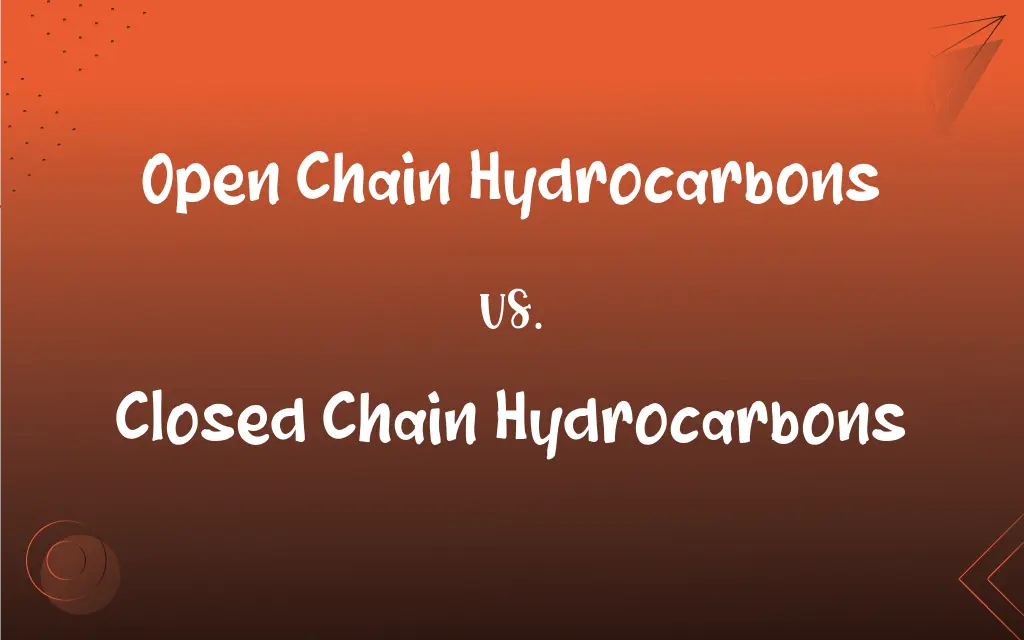Open Chain Hydrocarbons vs. Closed Chain Hydrocarbons: What's the Difference?
Edited by Aimie Carlson || By Janet White || Published on March 28, 2024
Open chain hydrocarbons have straight or branched chains without rings, while closed chain hydrocarbons form rings or cycles in their structure.

Key Differences
Open chain hydrocarbons, also known as aliphatic hydrocarbons, consist of carbon atoms linked in a linear or branched fashion. In contrast, closed chain hydrocarbons, known as cyclic hydrocarbons, have their carbon atoms connected in a loop or ring structure. This fundamental structural difference impacts their chemical properties and reactions.
The structural simplicity of open chain hydrocarbons allows for a wide range of lengths and complexities, leading to a vast number of possible compounds. On the other hand, closed chain hydrocarbons have a more complex arrangement, as their carbon atoms form one or more rings, influencing their chemical behavior and stability.
Open chain hydrocarbons can be either saturated, known as alkanes, or unsaturated, including alkenes and alkynes. Closed chain hydrocarbons also exhibit this variation; they can be either alicyclic, resembling alkanes in their saturation, or aromatic, with a special type of ring stability.
In terms of physical properties, open chain hydrocarbons generally have lower boiling and melting points compared to closed chain hydrocarbons of similar molecular weight, due to their less compact structure.
The reactivity of open chain hydrocarbons is primarily influenced by the presence of double or triple bonds and their chain length. In contrast, closed chain hydrocarbons' reactivity is heavily influenced by the nature of the ring, with aromatic rings being particularly stable and less reactive under certain conditions.
ADVERTISEMENT
Comparison Chart
Basic Structure
Linear or branched chains without rings.
Carbon atoms form ring structures.
Types
Alkanes, Alkenes, Alkynes (saturated/unsaturated).
Alicyclic, Aromatic (saturated/unsaturated).
Physical Properties
Generally lower boiling/melting points.
Higher boiling/melting points.
Stability
Stability varies with saturation.
Ring structures often add stability.
Chemical Reactivity
Influenced by bond type and chain length.
Ring nature heavily influences reactivity.
ADVERTISEMENT
Open Chain Hydrocarbons and Closed Chain Hydrocarbons Definitions
Open Chain Hydrocarbons
They can be either saturated (alkanes) or unsaturated (alkenes, alkynes).
Ethene, an unsaturated open chain hydrocarbon, is used in the production of plastics.
Closed Chain Hydrocarbons
They often exhibit higher stability and boiling points than open chain hydrocarbons.
Toluene, a derivative of closed chain hydrocarbon benzene, is used as a solvent.
Open Chain Hydrocarbons
They exhibit simpler structures compared to closed chain hydrocarbons.
Butane, a simple open chain hydrocarbon, is used as a fuel in lighters.
Closed Chain Hydrocarbons
Closed chain hydrocarbons feature carbon atoms connected in rings.
Cyclohexane, a closed chain hydrocarbon, is used in the production of nylon.
Open Chain Hydrocarbons
Open chain hydrocarbons are characterized by their straight or branched structures.
Hexane, a straight-chain open chain hydrocarbon, is used in adhesives.
Closed Chain Hydrocarbons
Closed chain hydrocarbons are characterized by their ring or cyclic structures.
Cyclopropane, a three-carbon closed chain hydrocarbon, is used as an anesthetic.
Open Chain Hydrocarbons
Open chain hydrocarbons consist of carbon atoms linked linearly or branched.
Pentane, a type of open chain hydrocarbon, is commonly used as a solvent.
Closed Chain Hydrocarbons
Closed chain hydrocarbons play a vital role in chemical synthesis and materials science.
Naphthalene, a polycyclic closed chain hydrocarbon, is used in mothballs.
Open Chain Hydrocarbons
Open chain hydrocarbons are fundamental to organic chemistry and industrial applications.
Propyne, an open chain hydrocarbon, is used in welding and cutting applications.
Closed Chain Hydrocarbons
They include alicyclic compounds (saturated) and aromatic compounds (unsaturated).
Benzene, an aromatic closed chain hydrocarbon, is a precursor in many industrial processes.
FAQs
Can open chain hydrocarbons be branched?
Yes, they can have linear or branched structures.
Do open chain hydrocarbons have higher boiling points than closed chain ones?
Generally, open chain hydrocarbons have lower boiling points.
Are closed chain hydrocarbons always aromatic?
No, they can be either aromatic or alicyclic (non-aromatic).
What defines an open chain hydrocarbon?
Open chain hydrocarbons have a linear or branched structure without rings.
Are all closed chain hydrocarbons cyclic?
Yes, they are characterized by their ring or cyclic structures.
Do closed chain hydrocarbons play a role in synthetic materials?
Yes, they are crucial in synthesizing plastics, resins, and other materials.
Are open chain hydrocarbons common in nature?
Yes, they are widely found in natural compounds and fuels.
Is the chemical reactivity of open chain hydrocarbons predictable?
Their reactivity can be predicted based on bond type and chain length.
Are open chain hydrocarbons important in energy production?
Yes, they are key components of many fuels and energy sources.
What are closed chain hydrocarbons?
Closed chain hydrocarbons consist of carbon atoms forming ring structures.
What types of bonds can open chain hydrocarbons have?
They can have single, double, or triple bonds.
Do closed chain hydrocarbons have more complex structures?
Yes, the ring structure adds complexity compared to open chains.
Are open chain hydrocarbons less stable than closed chain ones?
Stability varies, but closed chain structures often add stability.
Can closed chain hydrocarbons be toxic?
Some, particularly aromatic hydrocarbons, can be hazardous.
Do closed chain hydrocarbons have unique optical properties?
Yes, especially aromatic hydrocarbons, which can absorb specific wavelengths of light.
Can closed chain hydrocarbons be part of larger molecules?
Yes, they can be components of larger and more complex molecules.
Are closed chain hydrocarbons used in pharmaceuticals?
Yes, many pharmaceutical compounds contain closed chain structures.
Do closed chain hydrocarbons have a distinct smell?
Some, like benzene, have a characteristic aroma.
Can open chain hydrocarbons be saturated or unsaturated?
Yes, they can be either, depending on the types of bonds present.
Are open chain hydrocarbons used in everyday products?
Yes, they are found in fuels, solvents, and many household products.
About Author
Written by
Janet WhiteJanet White has been an esteemed writer and blogger for Difference Wiki. Holding a Master's degree in Science and Medical Journalism from the prestigious Boston University, she has consistently demonstrated her expertise and passion for her field. When she's not immersed in her work, Janet relishes her time exercising, delving into a good book, and cherishing moments with friends and family.
Edited by
Aimie CarlsonAimie Carlson, holding a master's degree in English literature, is a fervent English language enthusiast. She lends her writing talents to Difference Wiki, a prominent website that specializes in comparisons, offering readers insightful analyses that both captivate and inform.































































